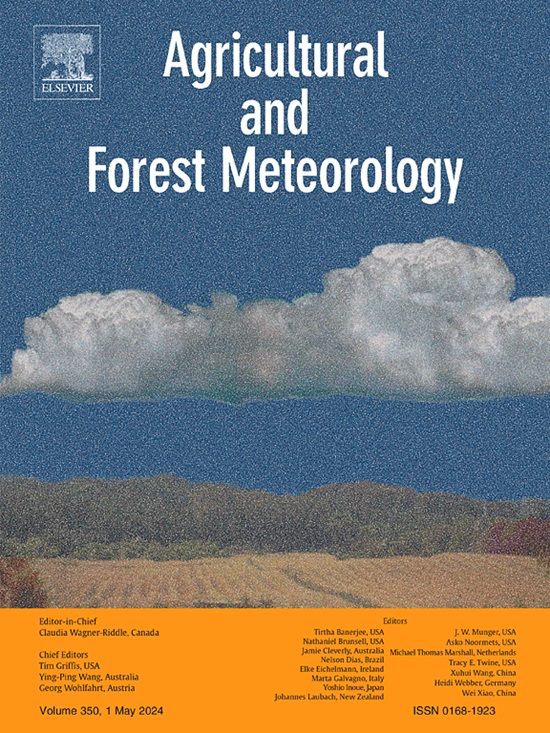Regional scale multi-crop water footprint quantification based on improved WOFOST model and remote sensing data assimilation
IF 5.7
1区 农林科学
Q1 AGRONOMY
引用次数: 0
Abstract
Addressing global water scarcity and food security, quantifying crop water footprints is essential for improving agricultural water use efficiency. Field trials in Horqin Left Wing Middle Banner, Inner Mongolia (2021–2022) explored efficient water use. A C-WOFOST model with a water balance module was developed, achieving Nash-Sutcliffe Efficiency (NSE) values over 0.8 for maize, beet, and sunflower’s LAI and soil moisture. Using Ensemble Kalman Filter (EnKF) for data assimilation, the coefficient of determination (R²) for maize, beet, and sunflower yields increased by 32.7 %, 69.4 %, and 43.6 %, respectively. Integrated with ArcGIS and U-Net for high-resolution analysis, the model showed maize had the highest water footprint, followed by sunflower and sugar beet. Maize’s WFgreen was 11.6 % higher than its WFblue, while sugar beet had the lowest water footprint, with nearly equal contributions from WFgreen and WFblue. Environmental conditions influenced water footprint distribution, with higher WFblue in the east and higher WFgreen in the west. The study suggests prioritizing crops with lower irrigation needs, such as sugar beet, in water-scarce areas and optimizing irrigation or selecting salt-tolerant varieties for high-demand crops like maize. The findings provide insights for sustainable water resource management in salinized regions.
基于改进WOFOST模型和遥感数据同化的区域尺度多作物水足迹量化研究
为解决全球水资源短缺和粮食安全问题,量化作物水足迹对提高农业用水效率至关重要。内蒙古科尔沁左翼中旗(2021-2022)田间试验探索高效用水。建立了含水分平衡模块的C-WOFOST模型,玉米、甜菜和向日葵的LAI和土壤水分的NSE值均大于0.8。采用集成卡尔曼滤波(EnKF)进行数据同化,玉米、甜菜和向日葵产量的决定系数(R²)分别提高了32.7%、69.4%和43.6%。该模型结合ArcGIS和U-Net进行了高分辨率分析,结果显示玉米的水足迹最高,其次是向日葵和甜菜。玉米的WFgreen比WFblue高11.6%,而甜菜的水足迹最低,WFgreen和WFblue的贡献几乎相等。环境条件对水足迹的分布有影响,水足迹的蓝、绿分别呈东部高、西部高的趋势。该研究建议在缺水地区优先种植灌溉需求较低的作物,如甜菜,并优化灌溉或为玉米等高需求作物选择耐盐品种。研究结果为盐渍化地区的可持续水资源管理提供了见解。
本文章由计算机程序翻译,如有差异,请以英文原文为准。
求助全文
约1分钟内获得全文
求助全文
来源期刊
CiteScore
10.30
自引率
9.70%
发文量
415
审稿时长
69 days
期刊介绍:
Agricultural and Forest Meteorology is an international journal for the publication of original articles and reviews on the inter-relationship between meteorology, agriculture, forestry, and natural ecosystems. Emphasis is on basic and applied scientific research relevant to practical problems in the field of plant and soil sciences, ecology and biogeochemistry as affected by weather as well as climate variability and change. Theoretical models should be tested against experimental data. Articles must appeal to an international audience. Special issues devoted to single topics are also published.
Typical topics include canopy micrometeorology (e.g. canopy radiation transfer, turbulence near the ground, evapotranspiration, energy balance, fluxes of trace gases), micrometeorological instrumentation (e.g., sensors for trace gases, flux measurement instruments, radiation measurement techniques), aerobiology (e.g. the dispersion of pollen, spores, insects and pesticides), biometeorology (e.g. the effect of weather and climate on plant distribution, crop yield, water-use efficiency, and plant phenology), forest-fire/weather interactions, and feedbacks from vegetation to weather and the climate system.

 求助内容:
求助内容: 应助结果提醒方式:
应助结果提醒方式:


